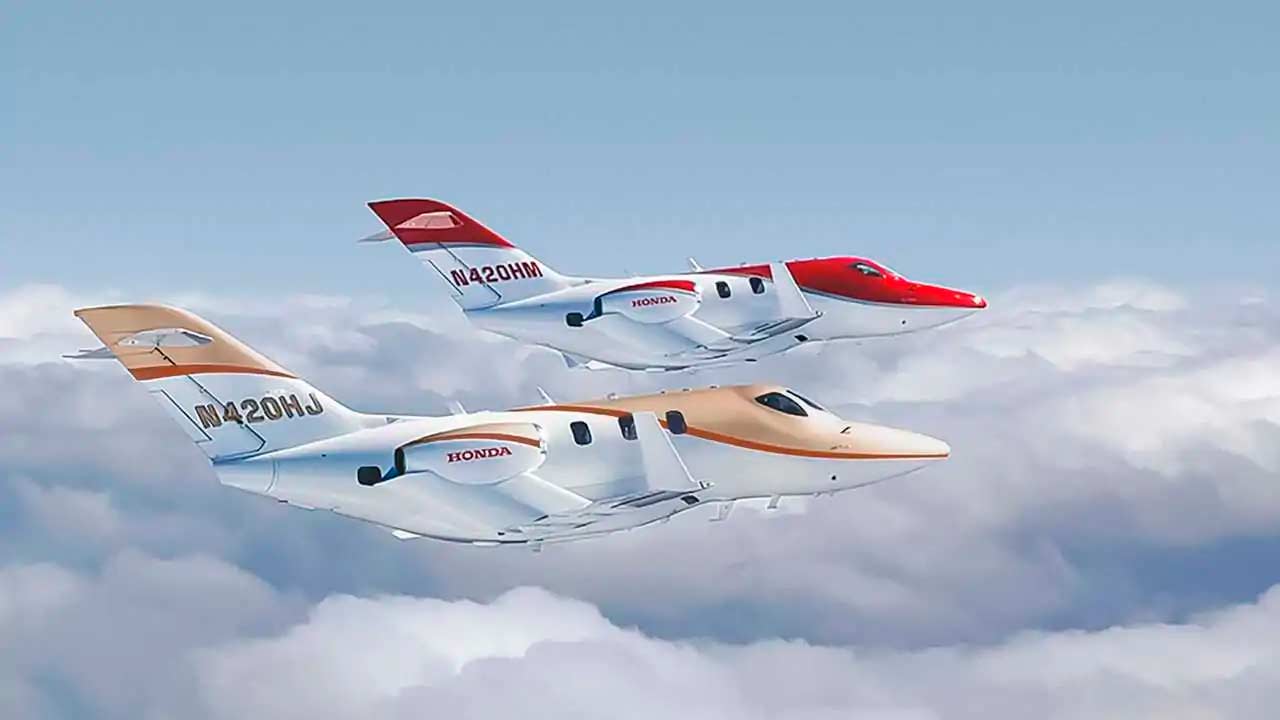GREENSBORO, N.C. – May , 2021 – Honda Aircraft Company today revealed a new upgraded aircraft, the “HondaJet Elite S,” at its first ever virtual product launch event themed “Innovation Continues: Elite S.”
The HondaJet Elite S features several upgrades that expand operational capability and improve flight operation. With an increased maximum takeoff weight of 200 lbs., customers can now fly up to 120 nm (138 mi) further* at a higher payload, or take an additional passenger* during their typical mission.
Additionally, the new avionics features of FAA DataComm and ACARS replace traditional voice commands with text-based messaging to improve the clarity and efficiency of communications. Combined with the newly introduced Advanced Steering Augmentation System (ASAS), the Elite S further reduces pilot workload and maximizes safety.
Honda Aircraft Company the HondaJet Elite S
Taking the HondaJet’s signature exterior profile to the next level, the HondaJet Elite S introduces new styling with exclusive paint schemes available in Gunmetal, Luxe Gold, and Deep Sea Blue. These new color options are topped off with a signature Elite S logo, with the bold red S and further customization available depending on exterior color selections.

While introducing the HondaJet Elite S, Honda Aircraft Company unveiled an Elite S with a special paint scheme, which represents the company’s continued commitment to research and development of leading-edge technology to realize new possibilities and propose new value for business aviation.
“Since its introduction in 2018, the HondaJet Elite has achieved the best performance in its class while also being the most efficient, and with the new Elite S, we take another step forward in expanding the aircraft’s capability,” said Honda Aircraft Company’s President and CEO Michimasa Fujino. “As a result of the innovation, design and engineering on the new Elite S, we are once again setting a new standard in business aviation.”
The HondaJet Elite S has inherited the aeronautical breakthroughs developed by Honda Aircraft Company, including the Over-The-Wing Engine Mount (OTWEM) configuration, Natural Laminar Flow (NLF) fuselage nose and wing, composite fuselage and a highly customized avionics suite. The aircraft continues to be the most efficient, quietest, fastest, highest, and farthest-flying in its class. *additional range benefit begins to phase in above 650 lbs. of payload; additional passenger/payload benefit ranges from 170-200 lbs. depending on range of mission
– Key new features of the HondaJet Elite S –
Increased Gross Weight 200 lbs.
• Carry additional payload for the same distance, or load more fuel and fly further with the same payload.
Avionics Software Upgrade *optional featuresA
Building on the highly customized HondaJet avionics suite based on G3000, the Elite S introduces several new advanced features enabling more seamless communication and reduced pilot workload for more efficient operations.
• FAA Data Comm: Functionality intended to replace traditional voice commands with text based messaging for departure clearance and enroute services where available in the United States.
• ACARS: Enables text based messaging with both air traffic services and operation centers. Air traffic services include terminal information, terminal weather, and departure clearance from supported airports. ACARS also provides several functionalities for communicating with operation centers including: flight plan upload, messaging, weather, and automatic transmission of position reporting and Out/Off/On/In status.
• COM3: This functionality allows the operator to disable the Datalink Mode of the radio and use it as a 3rd VHF, to increase dispatch reliability. This function will come with selection of FAA Data Comm and ACARS.
Advanced Steering Augmentation System (ASAS)
• Advanced Steering Augmentation System (ASAS) reduces pilot workload and enhances safety for missions in specific weather conditions.
New Styling Options
• New exterior paint schemes: Gunmetal, Luxe Gold, Deep Sea Blue
• Several color options for the new Elite S logo with the bold red S as a standard offering.
For more information, visit hondajet.com.
About the HondaJet Elite S
The HondaJet Elite S is the fastest, farthest and highest-flying plane in its class. The HondaJet Elite S incorporates Honda Aircraft’s many technological innovations, including the unique Over-The-Wing Engine Mount (OTWEM) configuration, Natural Laminar Flow (NLF) nose and wing, and composite fuselage. The aircraft is also powered by the GE Honda Aero Engines HF120. All of these advancements contribute to the aircraft’s superior performance, unparalleled efficiency and maximized fuselage space, making the aircraft’s cabin the largest in its class. The HondaJet Elite S cabin features a full service galley, a private lavatory with optional belted seat and an industry first Bongiovi sound system. The aircraft sets the standard in safety and human-machine interface technology with an ergonomically designed cockpit and highly customized Garmin® G3000 avionics suite.
Honda Aircraft continues to be committed to improving lives through personal mobility, while living in a sustainable society. The HondaJet Elite S remains significantly more fuel efficient and emits less greenhouse gases than all other similarly sized twin-engine business jets. Certified for single pilot operations, the HondaJet Elite S continues to live up to the company’s reputation for superior performance, efficiency, quality, and value.
About Honda Aircraft Company
Honda Aircraft Company is a wholly owned subsidiary of American Honda Motor Co., Inc. Founded in 2006, Honda Aircraft’s world headquarters is located in North Carolina, the birthplace of aviation. The challenging spirit upon which Mr. Soichiro Honda founded Honda Motor Co., Ltd. is alive today as Honda Aircraft fulfills one of Honda’s longstanding dreams to advance human mobility skyward.










